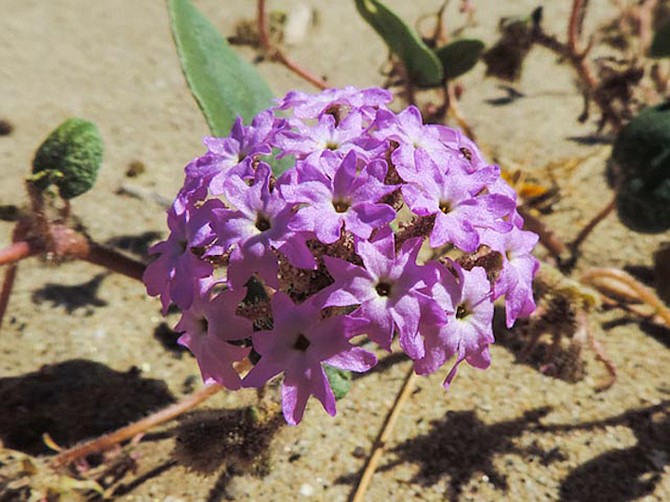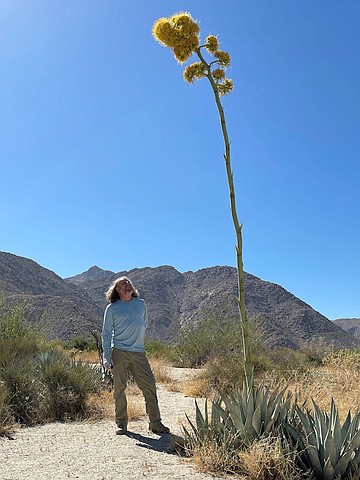 Facebook
Facebook
 X
X
 Instagram
Instagram
 TikTok
TikTok
 Youtube
Youtube

At over 640,000 acres, Anza Borrego Desert State Park in eastern San Diego County is the largest state park in the contiguous 48 states. As of July 29 it will grow by 17,597 acres, adding to a domain that stretches beyond the northern reaches of the county to within one mile of the international border.
When Anza Borrego Desert State Park was officially created in 1933, it encompassed a checkerboard of private lands (about 68,000 acres) mixed in with park holdings. That happened because planning for park creation was going on simultaneously with development of the town of Borrego Springs during the 1920s. Speculators were dividing and selling desert parcels, talking up mineral rights and the possibility of oil. In Depression days that sounded really promising.
But by the 1960s, when Anza Borrego Foundation began its work, those private holdings remained largely unoccupied and presented a challenge for the state park system to manage. The foundation was formed at the behest of the California State Park Commission to fill in the gaps. The current 17,597-acre transfer represents 29 years of acquisition, a combination of 331 separate parcels donated or paid for with foundation funds and grants. The largest single parcel is 690 acres; the smallest is a 3-foot by 402-foot former mining claim.

One highlight of the new additions: a portion of Lucky 5 Ranch that expands the connection between Cuyamaca Rancho State Park and Anza Borrego, forming a continuous link from coastal mountain habitat to desert for wildlife—such as mountain lions, bobcats, gray fox and golden eagles—to roam. Hundreds of acres of wildflower fields along Henderson Canyon Road are also now part of the state park.
Also added: a bundle of parcels totaling 6,000 acres in Coyote Canyon, watershed of the whole Borrego Valley, and 3,500 acres of Borrego Badlands, current home of the Flat Tail Horned Lizard and previous home of dinosaurs. Anza Borrego is the only state park to have a full-time paleontologist on staff. Fossils found in the park include prehistoric camels, wooly mammoths, and “terror birds.” A beak found in the Badlands in the 1960s was classified as that of Titanis: a six-foot-tall flightless bird that lived from 2 to 62 million years ago.
In her quest to add “pieces to the puzzle,” Anza Borrego Foundation land program manager Julie Gerson communicates with landowners scattered all over the country. She has a list of about 350 names whom she regularly sends letters of appeal to sell or donate.
“A story I hear again and again — relatives inherited the deed from parents or grandparents who bought it in the 30s.” In those days, Gerson said, speculators were selling 10 acres for $10, making it look good on a map, with roads, easements, and access to services. But in reality it was never developed, and most of this land remains largely inaccessible. Mineral and oil discoveries obviously didn’t pan out.
“When they see the land is in San Diego County, they think it must be worth a lot. They’ve never been here, they don’t know it’s a desert. They’re surprised to find out their 10 acres is only worth about $4,000.” Also surprising—much of the land is in a flash flood zone, where storms can bring two feet of water in just a few hours. Strict building codes make development more expensive.
Gerson said it would take about $10 million to acquire the remainder of private land, about 14,000 acres, still mixed in with Anza Borrego Desert State Park. Land close to Borrego Springs is worth about $400-$600 per acre, in rare cases up to $800. “We’re only looking for willing sellers or donors,” Gerson said.


At over 640,000 acres, Anza Borrego Desert State Park in eastern San Diego County is the largest state park in the contiguous 48 states. As of July 29 it will grow by 17,597 acres, adding to a domain that stretches beyond the northern reaches of the county to within one mile of the international border.
When Anza Borrego Desert State Park was officially created in 1933, it encompassed a checkerboard of private lands (about 68,000 acres) mixed in with park holdings. That happened because planning for park creation was going on simultaneously with development of the town of Borrego Springs during the 1920s. Speculators were dividing and selling desert parcels, talking up mineral rights and the possibility of oil. In Depression days that sounded really promising.
But by the 1960s, when Anza Borrego Foundation began its work, those private holdings remained largely unoccupied and presented a challenge for the state park system to manage. The foundation was formed at the behest of the California State Park Commission to fill in the gaps. The current 17,597-acre transfer represents 29 years of acquisition, a combination of 331 separate parcels donated or paid for with foundation funds and grants. The largest single parcel is 690 acres; the smallest is a 3-foot by 402-foot former mining claim.

One highlight of the new additions: a portion of Lucky 5 Ranch that expands the connection between Cuyamaca Rancho State Park and Anza Borrego, forming a continuous link from coastal mountain habitat to desert for wildlife—such as mountain lions, bobcats, gray fox and golden eagles—to roam. Hundreds of acres of wildflower fields along Henderson Canyon Road are also now part of the state park.
Also added: a bundle of parcels totaling 6,000 acres in Coyote Canyon, watershed of the whole Borrego Valley, and 3,500 acres of Borrego Badlands, current home of the Flat Tail Horned Lizard and previous home of dinosaurs. Anza Borrego is the only state park to have a full-time paleontologist on staff. Fossils found in the park include prehistoric camels, wooly mammoths, and “terror birds.” A beak found in the Badlands in the 1960s was classified as that of Titanis: a six-foot-tall flightless bird that lived from 2 to 62 million years ago.
In her quest to add “pieces to the puzzle,” Anza Borrego Foundation land program manager Julie Gerson communicates with landowners scattered all over the country. She has a list of about 350 names whom she regularly sends letters of appeal to sell or donate.
“A story I hear again and again — relatives inherited the deed from parents or grandparents who bought it in the 30s.” In those days, Gerson said, speculators were selling 10 acres for $10, making it look good on a map, with roads, easements, and access to services. But in reality it was never developed, and most of this land remains largely inaccessible. Mineral and oil discoveries obviously didn’t pan out.
“When they see the land is in San Diego County, they think it must be worth a lot. They’ve never been here, they don’t know it’s a desert. They’re surprised to find out their 10 acres is only worth about $4,000.” Also surprising—much of the land is in a flash flood zone, where storms can bring two feet of water in just a few hours. Strict building codes make development more expensive.
Gerson said it would take about $10 million to acquire the remainder of private land, about 14,000 acres, still mixed in with Anza Borrego Desert State Park. Land close to Borrego Springs is worth about $400-$600 per acre, in rare cases up to $800. “We’re only looking for willing sellers or donors,” Gerson said.
Comments